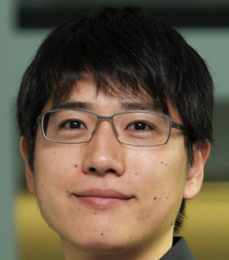Neural Basis of Perception
Team Leader : Naoya Takahashi

Naoya Takahashi received his PhD at the University of Tokyo (advisor: Prof. Yuji Ikegaya), studying spatial organization of synaptic inputs in dendrites. He moved to Berlin for his postdoc at the laboratory Prof. Matthew Larkum (Humboldt University), where he studied active roles of cortical neuron dendrites in somatosensory processing. As a recipient of the Grass Fellowship in 2018, he worked as a summer investigator at the Marine Biological Laboratory (Woods Hole, MA).
Since 2020, he is a team leader at the Institute for Interdisciplinary Neuroscience (IINS). By combining a wide range of tools and methods in neurophysiology and behavioral neuroscience, his team aims to understand cellular and circuit mechanisms that controls tactile perception in mice.
General objective

Attention and contextual knowledge are prerequisites for perception and decision making. The goal of my team is to identify the neuronal mechanisms underlying cognitive control and contextual modulation of perception and behavioral actions.
Towards this goal, my team focuses on tactile sensation in mice, one of the most predominant sensory modalities in rodents to perceive the world. We investigate how tactile inputs are processed and modulated in the somatosensory cortex. Our particular interest lies in understanding the synaptic and dendritic processes that shape the output of single cortical neurons at different brain states (e.g., attention) and contexts (e.g., behavioral demands).
We use a variety of in vivo techniques to achieve these goals: two-photon and one-photon subcellular imaging, whole-cell patch clamp recording, optogenetics and chemogenetics, virus-mediated circuit tracing, psychophysical analysis of mouse tactile behavior. We also have an interest in developing new imaging tools and genetic/molecular tools via collaborations to probe cortical activity with subcellular resolution in awake behaving mice.
Expertise
News
The team received an Equipe FRM award
Cortical mechanisms for tactile information processing during tool use
Scientific abstract
Tool-mediated tactile sensing is a crucial aspect of daily life. For instance, when using a fork, we can extract the food's location and texture as if the fork were part of our body. Similarly, a blind person uses a cane to perceive their surroundings and accurately estimate object locations. The brain incorporates tools like forks or canes into the “body schema” – the internal representation of our own body and its surroundings, which can be expanded by tools. This schema is believed to be maintained and constantly updated in the frontoparietal cortical network, enabling the brain to interpret somatosensory information and create a coherent tactile experience and perception of the surrounding space. However, the specific neuronal processes involved are largely unexplored.
Given the unique nature of rodent whiskers, non-neuronal, extra-somatic elements, we propose using the mouse whisker system, as a new model to study neural mechanisms in tool-mediated object localization. Furthermore, our research takes a novel approach with “prosthetic whiskers,” artificial whiskers that substitute a mouse’s innate whiskers, offering a unique opportunity to examine neuronal processes in the context of “extrinsic” tool use in mice.
The proposed study aims to test the hypothesis that the layer 1 of the primary somatosensory cortex, receiving feedback from the frontoparietal network, integrates body schema and somatosensory information during tool use. Utilizing advanced imaging and genetic manipulation, we will delve into neuronal processes from subcellular to network levels, as mice employ innate or prosthetic whiskers for object localization. This research would revolutionize our understanding of the neurophysiological underpinnings of tactile processing during tool use.
Lay abstract
How does the brain process tactile information through hand-held tools? While eating with a fork, the position and texture of the food is felt at the tips of the fork rather than at hand. Although the sensory input in this example is received at the hand surface, the tactile sensation of the food is created in the body space extended by the fork. Despite the prevalence of tool-based tactile sensing in daily life, the underlying neuronal processes remain largely unknown. This gap is due in large part to the fact that most of the neurophysiological studies of tool use are conducted in humans and monkeys, where only limited techniques and tools can be applied. To overcome this limitation, for this study, we will use mice, an animal model unconventional for the tool-use experiment. Mice have whiskers as innate tools, and we have recently developed artificial "prosthetic whiskers" that can replace them. By monitoring and manipulating neuronal activities with cellular and subcellular resolution, we will decipher the neuronal underpinnings that regulate tactile sensing during tool use. Our primary target is the layer 1 of the primary somatosensory cortex, where feed-forward somatosensory information is integrated with feedback information from higher-order cortical areas implicated in tool use. By taking full advantage of state-of-the-art techniques available for mouse research, the proposed study seeks to reveal the neurophysiological mechanisms of tactile processing during tool use in unprecedented detail. The insights gained would significantly enhance our understanding of the neural underpinnings of tool-based tactile sensing. Moreover, this research may have implications for other research areas, for example, paving the way for the design of neuroprosthetics with enhanced tactile sensing capabilities.
Selected Publications
MORE
MORE
MORE
MORE
MORE
MORE
MORE
MORE
« Postdoc »
| MAZO Camille | Postdoc | camille.mazo@u-bordeaux.fr | +33533514700 | |
| NAUD Richard | Postdoc | richard.naud@u-bordeaux.fr | +33533514700 | |
| RUBEN Massimo | Postdoc | massimo.ruben@u-bordeaux.fr | +33533514700 |  |
« PhD student »
| GARNIER ARTIÑANO Tomas | PhD student | tomas.garnier-artinano@u-bordeaux.fr | +33533514700 |  |
